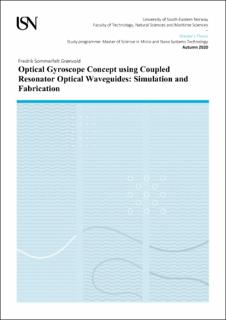Optisk gyroskop konsept ved bruk av koblet resonator optisk bølgeleder: simulering og fabrikasjon
Master thesis
Permanent lenke
https://hdl.handle.net/11250/2757267Utgivelsesdato
2020Metadata
Vis full innførselSamlinger
Sammendrag
Koblede koblede resonator optiske bølgeledere (CROW) har vist stort potensial som optiske gyroskoper, og oppnår følsomhet for ytelsen til navigasjonsgrad. Imidlertid er de bare overlegne over enkle ring resonatorer når tapet er lite. I denne oppgaven ble beregningsverktøy for å bestemme forplantningsmodus og konstant utviklet ved bruk av endelig differens frekvens domene (FDFD) i MATLAB og utvidet til å omfatte anisotrope materialer. Metodene viser god relasjon til litteraturen og til andre numeriske metoder som endelig elementmodellering med COMSOL. Verktøyene kan fremdeles utvikles videre for å øke nøyaktigheten og omfanget.Fremstillingen av bølgeledere, resonatorer og CROW ble utført ved hjelp av en maskeløs fotolitografisk prosess med PicoMaster 150PM laserskriveren. Prosessen led imidlertid av problemer med overutvikling og fabrikasjonsoptimalisering. Fremtidig arbeid bør enten prøve å optimalisere fabrikasjonsprosessen eller bruke andre metoder for å produsere bølgelederne. Coupled Resonator Optical Waveguides (CROW) have shown great potential as optical gyroscopes, achieving sensitivity of navigation grade performance. However, they are only superior to single ring resonators when the loss is small. In this thesis finite difference frequency domain (FDFD) computational tools for determining the propagation mode and constant were developed in MATLAB and expanded upon to include anisotropic materials. The methods show good relation to the literature and to other numerical methods like finite element modelling with COMSOL. The tools can still be developed further to increase accuracy and scope.The fabrication of waveguides, resonators and CROW were done using a maskless photolithographic process with the PicoMaster 150PM laser writer. The process however, suffered from over-development and fabrication optimisation issues. Future work should either try to optimise the fabrication process or use other methods to fabricate the waveguides.
